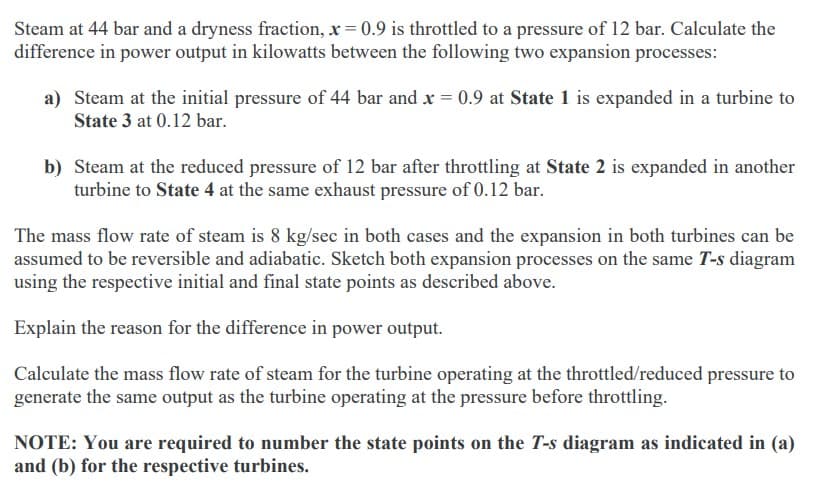Steam at 44 bar and a dryness fraction, x = 0.9 is throttled to a pressure of 12 bar. Calculate the difference in power output in kilowatts between the following two expansion processes: a) Steam at the initial pressure of 44 bar and x = 0.9 at State 1 is expanded in a turbine to State 3 at 0.12 bar. b) Steam at the reduced pressure of 12 bar after throttling at State 2 is expanded in another turbine to State 4 at the same exhaust pressure of 0.12 bar. The mass flow rate of steam is 8 kg/sec in both cases and the expansion in both turbines can be assumed to be reversible and adiabatic. Sketch both expansion processes on the same T-s diagram using the respective initial and final state points as described above. Explain the reason for the difference in power output. Calculate the mass flow rate of steam for the turbine operating at the throttled/reduced pressure to generate the same output as the turbine operating at the pressure before throttling. NOTE: You are required to number the state points on the T-s diagram as indicated in (a) and (b) for the respective turbines.
Steam at 44 bar and a dryness fraction, x = 0.9 is throttled to a pressure of 12 bar. Calculate the
difference in power output in kilowatts between the following two expansion processes:
a) Steam at the initial pressure of 44 bar and x = 0.9 at State 1 is expanded in a turbine to
State 3 at 0.12 bar.
b) Steam at the reduced pressure of 12 bar after throttling at State 2 is expanded in another
turbine to State 4 at the same exhaust pressure of 0.12 bar.
The mass flow rate of steam is 8 kg/sec in both cases and the expansion in both turbines can be
assumed to be reversible and adiabatic. Sketch both expansion processes on the same T-s diagram
using the respective initial and final state points as described above.
Explain the reason for the difference in power output.
Calculate the mass flow rate of steam for the turbine operating at the throttled/reduced pressure to
generate the same output as the turbine operating at the pressure before throttling.
NOTE: You are required to number the state points on the T-s diagram as indicated in (a)
and (b) for the respective turbines.

Step by step
Solved in 7 steps with 9 images









